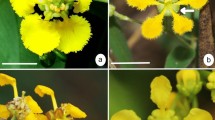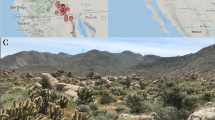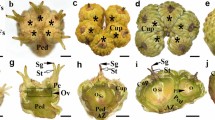Abstract
The reproductive biology of Primula merrilliana Schltr. and P. cicutariifolia Pax that are sister taxa and the only two members of Primula sect. Ranunculoides were studied. The results showed that P. merrilliana is typically a distylous species not only in morphology but also in function; it has an incompatibility system that restricts the legitimate pollination to that between pin and thrum flower morphs, but self-fertilization may occur under certain conditions. P. cicutariifolia is self-compatible. The pin morph of P. merrilliana has longer stigma papillae and smaller pollen than the thrum morph. The results stated above support the view that P. filchnerae should be moved from sect. Pinnatae to sect. Auganthus.





Similar content being viewed by others
References
Anderson GJ, Bernardello G, Lopez PS, Crawford DJ, Stuessy TF (2000) Reproductive biology of Wahlenbergia (Campanulaceae) endemic to Robinson Crusoe Island (Chile). Plant Syst Evol 223:109–123
Anderson GJ, Bernardello G, Stuessy TF, Crawford DJ (2001) Breeding system and pollination of selected plants endemic to Juan Fernandez Islands. Am J Bot 88:220–233
Arnold ES, Richards AJ (1998) On the occurrence of unilateral incompatibility in Primula section Aleuritia Duby and the origin of Primula scotica Hook. Bot J Linn Soc 128:359–368
Barrett SCH (1990) The evolution and adaptive significance of heterostyly. Trends Ecol Evol 5:144–148
Barrett SCH (1992) Heterostylous genetic polymorphisms: model systems for evolutionary analysis. In: Barrett SCH (ed) Evolution and function of heterostyly. Springer, Berlin, pp 1–29
Barrett SCH, Jesson LK, Baker AM (2000) The evolution and function of stylar polymorphisms in flowering plants. Ann Bot 85(Suppl A):253–265
Bawa KS (1980) Evolution of dioecy in flowering plants. Annu Rev Ecol Syst 11:15–39
Bernardello G, Anderson GJ, Patricio LS, Cleland MA, Stuessy TF, Crawford DJ (1999) Reproductive biology of Lactoris fernandeziana (Lactoridaceae). Am J Bot 86(6):829–840
Brys R, Jacquemyn H, Endels P et al (2004) Reduced reproductive success in small populations of the self-incompatible Primula vulgaris. J Ecol 92:5–14
Chen FH, Hu QM (1979) Taxonomy and distribution of Lysimachia in China. Acta Phytotax Sin 17(4):21–53
Chen ML, Zhang XP (2002) A study on the ecological features of Primula merrilliana, a rare and endangered plant species. J Anhui Norm Univ (Nat Sci) 25(4):371–374
Chen ML, Zhang XP (2003) Studies on optimization of the concentration of compositions in RAPD experiment of Primula merrilliana. J Anhui Norm Univ (Nat Sci) 26(3):264–267
Chizuru M, Izumi W (2000) Effects of population size and pollinator limitation on seed-set of Primula sieboldii populations in a fragmented landscape. Ecol Res 15:307–322
Darlington CD (1939) Evolution of genetic systems. Cambridge University Press, Cambridge
Darwin C (1877) The different forms of flowers on plants of the same species. Appleton & Co, New York
Endels P, Jacquemyn H, Brys R, Hermy M (2002) Changes in pin-thrum ratios in populations of the heterostyled Primula vulgaris Huds: does imbalance affect population persistence? Flora 197:326–331
Evans MEK, Dolan RW, Menges ES, Gordon DRG (2000) Genetic diversity and reproductive biology in Warea carteri (Brassicaceae), a narrowly endemic Florida scrub annual. Am J Bot 87:372–381
Faivre AE, Mcdade LA (2001) Population-level variation in the expression of heterostyly in three species of Rubiaceae: does reciprocal placement of anthers and stigmas characterize heterostyly? Am J Bot 88:841–853
Ganders FR (1979) The biology of heterostyly. N Z J Bot 17:607–635
Guaratini MTC, Solferini VN, Semir J (2004) Reproductive biology in species of Bidens L. (Asteraceae). Sci Agri 61(2):185–189
Hao G, Hu QM, Lee N (2004) Circumscriptions and phylogenetic relationships of Primula sects. Auganthus and Ranunculoides: evidence from nrDNA ITS sequences. Acta Bot Sin 44(1):72–75
He YP, Liu JQ (2003) A review on recent advances in the studies of plant breeding system. Acta Phytoecol Sin 27(2):151–163
Hong DY (1983) On pollen shape in some groups of dicotyledons. Grana 22:73–78
Hu CM (1990) Primulaceae (2). In: Chen FH, Hu CM (eds) Flora of China. Science Press, Beijing
Hu CM, Yang YC (1986) A revision of the genus Androsace L. in China. Acta Phytotax Sin 24(2):108–120
Jacquemyn H, Brys R, Hermy M (2002) Patch occupancy, population size and reproductive success of a rorest herb (Primula elatior) in a fragmented landscape. Oecologia 130:617–625
Jain SK (1976) The evolution of the selfing rate in functionally hermaphrodite plants and animals. Annu Rev Ecol Syst 24:441–466
Kato J, Mii M (2000) Differences in ploidy levels of inter-specific hybrids obtained by reciprocal crosses between Primula sieboldii and P. kisoana. Theor Appl Genet 101:690–696
Kearns CA, Inouye DW (1993) Techniqures for pollination biologists. University Press of Colorado, Niwot
Kelso S (1991) Taxonomy of Primula sects. Aleuritia and Armerrina in North America. Rhodora 93:67–99
Kéry M, Matthies D, Schmid B (2003) Demographic stochasticity in population fragments of the declining distylous perennial Primula veris (Primulaceae). Basic Appl Ecol 4:197–206
Kohn JR, Barrett SCH (1992) Experimental studies on the functional significance of heterostyly. Evolution 46:43–55
Kudoh H, Sugawara T, Wu SG, Murata J (2001) Morph-specific correlations between floral traits in a distylous Ophiorrhiza napoensis (Rubiaceae) population in southern China. J Trop Ecol 17:719–728
Larson BMH, Barrett SCH (1998) Reproductive biology of island and mainland populations of Primula mistassinica (Primulaceae) on Lake Huron shorelines. Can J Bot 76:1819–1827
Luyt R, Johnson SD (2001) Hawkmoth pollination of the African epiphytic orchid Mystacidium venosum, with special reference to flower and pollen longevity. Plant Syst Evol 228:49–62
Macior LW (1977) The pollination ecology of Pedicularis (Scrophulariaceae) in the Sierra Nevada of California. Bull Torrey Bot Club 104:148–154
Martins L, Oberprieler C, Hellwig FH (2003) A phylogenetic analysis of Primulaceae s.l. based on internal transcribed spacer (ITS) DNA sequence data. Plant Syst Evol 237:75–85
Mast AM, Kelso S, Richards AJ, Lang DJ, Feller DMS, Conti E (2001) Phylogenetic relationships in Primula L. and related genera (Primulaceae) based on noncoding chloroplast DNA. Int J Plant Sci 162(6):1381–1400
Mather K (1943) Polygenic inheritance and natural selection. Biol Rev 18:32–64
Mazer SJ, Hultgard UM (1993) Variation and covariation among floral traits within and among four species of Northern European Primula (Primulaceae). Am J Bot 80(4):474–485
Miller J, Litvak M, Kelso S, Vargo A (1994) Comparative reproductive biology of two alpine Primrose species. Arct Alp Res 26(3):297–303
Ornduff R (1972) The breakdown of trimorphic incompatibility in Oxalis section Corniculatae. Evolution 26(1):52–65
Pax F (1889) Monographische Übersicht über die Arten der Gattung Primula. Bot Jahrb Syst Pflanzengesch Pflanzengeogr 10:75–241
Piper JG, Charlesworth B, Charlesworth D (1984) A high rate of self-fertilization and increased seed fertility of homostyle primroses. Nature 310:50–51
Richards AJ (1993) Primula. Timber Press, New York
Richards AJ (1998) Lethal linkage and its role in the evolution of plant breeding systems. In: Owens SJ, Rudall PJ (eds) Reproductive biology in systematics, conservation, and economic botany. Royal Botanic Garden, Kew, pp 71–83
Richards JH, Ibrahim HB (1982) The breeding system in Primula veris L. II. Pollen tube growth and seed-set. New Phytol 90:305–314
Sage TL, Strumas F, Cole WW, Barrett SCH (1999) Differential ovule development following self- and cross-pollination: the basis of self-sterility in Narcissus triandrus Amarylliaceae. Am J Bot 86:855–870
Schoen DJ, Dubuc M (1990) The evolution of inflorescence size and number: a gamete-packaging strategy in plantas. Am Nat 135:841–857
Smith WW, Fletcher HR (1946) The genus Primula: sections Obconica, Sinenses, Reinii, Pinnatae, Malacoides, Bullatae, Carolinella, Garandis and Denticulata. Trans Roy Soc Edinb 61:415–478
Sprengel CK (1793) Das entdeckte Geheimniss der Natur im Bau und in der Befruchtung der Blumen. Friedrich Vieweg, Berlin
Stone JS, Thomson JD (1994) The evolution of distyly: pollen transfer in artificial flowers. Evolution 48:1595–1606
Tepedino VJ, Sipes SD, Griswold TL (1999) The reproductive biology and effective pollinators of the endangered beardtongue Penstemon penlandii (Scrophulariaceae). Plant Syst Evol 219:39–54
Værbak S, Andersen SB (1999) Selection for seed set capacity uncorrelated with flower heteromorphism in Primula vulgaris Hudson. Euphytica 105:1–5
Vuilleumier BS (1967) The origin and evolutionary development of heterostyly in the angiosperms. Evolution 21:210–226
Wadi HA, Richards AJ (1993) Primary homostyly in Primula L. subgenus Sphondylia (Duby) Rupr. and the evolution of distyly in Primula. New Phytol 124:239–338
Wang CY, Dang CL (1999) Plant mating system and its evolutionary mechanism in relation to population adaptation. J Wuhan Bot Res 17:163–172
Wang FX, Qian NF, Zhang YL (1995) Pollen morphology and plant taxonomy in China. Science Press, Beijing
Wedderburn F, Richards AJ (1990) Variation in within morph incompatibility sites in heteromorphic Primula L. New Phytol 116:149–162
Weller SG (1976) Breeding system polymorphism in a heterostylous species. Evolution 30:442–454
Wendelbo P (1961) Studies in Primulaceae. III. On the genera related to Primula with special reference to their pollen morphology. Arbok for Universitetet i Bergen, Matematisk-Naturvitenskapelig serie no. 19. Norwegian Universities Press, Bergen
Woodell SRJ (1960) What pollinates Primulas? New Sci 8:568–571
Worley AC, Baker AM, Thompson JD, Barrett SCH (2000) Floral display in Narcissus: variation in flower size and number at the species, population, and individual levels. Int J Plant Sci 161:69–79
Zhang YH (2001) Mastering SPSS. Qinghua University Press, Beijing
Zhang XP, Chen ML (2003) A study of genetic diversity of Primula merrilliana and P. cicutariifolia with assessing new ornamental resources. J Plant Resour Environ 12(3):1–5
Zhou SL, Pan KY, Hong DY (1996) Comparative studies on pollination biology of Mosla hangchouensis and M. chinensis (Labiatae). Acta Bot Sin 38(7):530–540
Author information
Authors and Affiliations
Corresponding author
Rights and permissions
About this article
Cite this article
Chen, M. Comparative reproductive biology of Primula merrilliana Schltr. and P. cicutariifolia Pax. Plant Syst Evol 278, 23–32 (2009). https://doi.org/10.1007/s00606-008-0125-9
Received:
Accepted:
Published:
Issue Date:
DOI: https://doi.org/10.1007/s00606-008-0125-9




